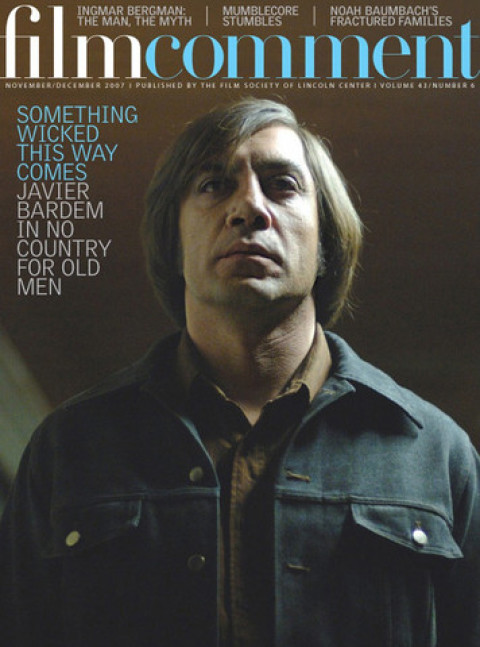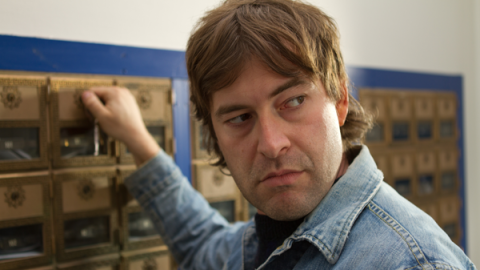
Frownland
Adieu, mumblecore, the indie movement that never was more than a flurry of festival hype and blogosphere branding.
Here’s some history gleaned from indieWIRE and various linked websites, which, as a way of grabbing attention in a dauntingly cluttered indie landscape, flogged mumblecore as the new happening thing. The chief promoter is Matt Dentler, who heads Austin’s South by Southwest Film Festival and is also a tireless blogger on behalf of the mumblecore “movement.” The quotation marks are Dentler’s, a recent tacit acknowledgement that his claim to fame is perhaps not the cinematic upheaval he once believed it to be. SXSW is probably the biggest benefactor of the mumblecore branding. Once known as the festival of Sundance rejects—not an entirely negative identity, given Sundance’s increasing blindness with regard to new talent—it is now the birthplace of mumblecore, and as such, worthy of mention in national print publications like Rolling Stone, which allotted a full page in its ’07 “Hot Issue” to a genealogy of mumblecore’s pantheon directors: Andrew Bujalski, Aaron Katz, Joe Swanberg, and the Duplass Brothers. (The billing order is mine, not Rolling Stone’s.) The directors have also benefited; it’s easier to drum up audiences for a “Hot Genre” than for any single starless, low-tech movie. The IFC Center, which presented a week of mumblecore under the title “The New Talkies: Generation diy,” acknowledged that while the series didn’t exactly sell out, the movies did better as a group than any one of them might have individually. In any case, theatrical release is a loss leader for DVD, where being associated with a brand is an even bigger plus. And in terms of the future of movie distribution, the mumblecore movies, for the moment, have a presence on the web, where download-on-demand is already a reality.
The term mumblecore reportedly was coined at SXSW in 2005 by Bujalski’s sound mixer, a guy whose primary experience with movies is, by virtue of his job, what he hears in his headphones. More than a soundperson’s nightmare, however, the mumbled speech in the movies that emerged as hardcore mumblecore is significantly overdetermined. On a technical level, these are micro-budget movies where sound is almost always a neglected element. When I first saw Bujalski’s Funny Ha Ha, in a 16mm print at the Pioneer Theater in 2002, the sound was so terrible in the Chinese restaurant scene that the buzz from the fluorescent lights drowned out the dialogue. (The track was cleaned up for the subsequent 35mm and DVD versions.)

LOL
In terms of performance, most of the actors favored by or simply available to these fledgling directors are nonprofessionals, who tend to swallow their words (particularly the ends of their sentences) because they are uncomfortable speaking on camera, whether their dialogue is scripted, improvised, or a combination of the two. In relation to meaning, these non-actors are perfect choices for these films because their insecurity and embarrassment about voicing their characters’ ideas, desires, and feelings is not merely symptomatic of their lack of technique, it dovetails with a defining characteristic of the particular cohort (white, middle-class, twenty-something) to which the filmmakers and their quasi-fictional characters belong. The mumblecore films literally speak in the voice of that cohort, and the best of them do so with remarkable and revealing precision. I once described Bujalski as a poet of demurral, hesitation, and noncommitment in whose films there are as many minute variations of meaning implied by the phrases “I don’t know” and “I mean” as there are said to be words for snow in the languages of the Inuit.
Is that, however, a sufficient basis for a film movement? Obviously not in the grand sense of the French New Wave or the postwar American avant-garde. At most, one might think of mumblecore as an update of the “New Talkie,” the strand (not quite a genre) of no-budget indies that emerged in the early Nineties with such landmark films as Richard Linklater’s Slacker, Kevin Smith’s Clerks, and Rose Troche and Guinevere Turner’s Go Fish. Within a broader history, one might trace it back to Warhol’s The Chelsea Girls and his related Sixties talkies. So specific was the chatter in all these films that they could have served as illustrations in a course on anthropological linguistics.

Hannah Takes the Stairs
An obvious difference, however, between the mumblecore moviemakers and their forerunners is the homogeneity of the new crowd. The directors are all male middle-class Caucasians, and they make movies exclusively about young adults who are involved in heterosexual relationships and who have jobs (when they have them) in workplaces populated almost exclusively by SWMs and SWFs. As a few bloggers who had their fill of the hype have noted, So Yong Kim’s lovely In Between Days (06) would seem to fit the mumblecore parameters (DIY production, a protagonist whose problems with language and communication frustrate her desire for a romantic relationship), but because the filmmaker is a Korean-American woman and her heroine is a Korean immigrant, no one thought to invite the movie to the party. Instead, the mumblecore guys selected Ry Russo-Young, who plays a supporting role in Swanberg’s Hannah Takes the Stairs (07), as their token female director even though her first feature, Orphans (07), with its heavy-handed visual metaphors and anguished examination of the symbiotic bond between two sisters, seems closer to Bergman than Bujalski.
The mumbler with the loudest mouth and the director of three defining mumblecore features—Kissing on the Mouth (05), LOL (06), and the aforementioned Hannah—is Swanberg, who commented on GreenCine last year that his work “is not about seclusion, it’s just a reflection of the white, hipster neighborhood I live in.” Deep-throating his own foot even further, he told Filmmaker magazine (in the Spring ’07 issue) that he didn’t feel he had “anything to say right now about the Iraq war. The story of my life and my friends’ lives are the ones I can tell most completely.” That Swanberg believes that his life and those of his friends are separate from the war or the global meltdown that is upon us seems to me reason enough to bring back the draft. I wouldn’t take these pronouncements seriously, were they not borne out by movies that are just as smug and blatantly lazy. (One blogger, trying to justify Swanberg’s importance, praised his “trademark casual camerawork.”) There’s a huge difference between the painful anomie that afflicts the main characters in Katz’s Quiet City (07) and the clueless narcissism of the men, and to a slighter lesser degree, the women in Swanberg’s oeuvre.

Kissing on the Mouth
Of Swanberg’s three movies, the first, Kissing on the Mouth, at least has a bit of energy, albeit of the “Look, Ma, I’m doing it” kind. “Doing it” is the operative phrase since all three movies are such fountains of lad-magazine culture that the DVDs might work as Maxim inserts. Swanberg has explained that he was moved to make Kissing as a rejoinder to what he felt was the buttoned-up quality of Bujalski’s Funny Ha Ha. And indeed, his greatest talent is for getting attractive, seemingly intelligent women to drop their clothes and evince sexual interest in an array of slobby guys who suffer from severely arrested emotional development. Swanberg is the DIY Judd Apatow. (Please do not let me see that line quoted on a DVD cover.) One might feel for the guys if they weren’t such insulated concoctions of guilt and self-aggrandizement. The director (I employ the term merely as a description of function) has cited his own particularly loutish onscreen persona as a sign that his movies are “critical” of male behavior. This supposed critical position is largely canceled out by the fact that the lout has become, by his own terms, a success (a photograph in Rolling Stone, women ever ready to get naked for his camera).
For a glimpse of how such criticism is accomplished, Swanberg should have a look at George Kuchar’s 1966 short Hold Me While I’m Naked, a film that comes to mind because it also features the director/star getting introspective in the shower. Unlike Swanberg, Kuchar manages to make us empathize with his frustration without showing his cock shooting its load on the tile wall. In addition to this bit of self-exposure, Kissing on the Mouth also opens with a notably realistic fucking scene and goes on to feature two bush-trimming scenes (one woman favors a razor, the other clippers). At some point, someone mentions what could have been the movie’s not-uninteresting premise—if only it had been developed: that many couples spend most of their relationship trying to break up. This has, of course, become the openly stated theme of the third season of Grey’s Anatomy. Perhaps the increasingly desperate writers have been watching mumblecore for inspiration. Dare I say that Swanberg has an obvious future in TV.
While mumblecore is already yesterday’s programming ploy, two of its core directors, Bujalski and Katz, are breakout talents, and their differences are far more interesting than their similarities. Bujalski, whose Funny Ha Ha and Mutual Appreciation (05) I’ve already covered in these pages, is a subtle writer and a fine director of actors who understands how to stage a scene so that body language speaks as strongly as words. Unlike Bujalski, whose loyalty to 16mm connects him to a long history of scrimp ’n’ salvage independent filmmaking, Katz works in DV, and his Dance Party USA (06) and Quiet City have a lyric beauty rarely associated with digital cinematography. (Sean McElwee shot the former, Andy Reed the latter). Katz’s sound design is as expressive as both his cityscape images and his ambient-light close-ups of characters lost in their own heads or engaged in tentative tête-à-têtes.

Quiet City
In both movies, a guy who’s cut off from his own feelings meets a girl whom he intuitively trusts and to whom he gradually opens his bruised heart. In Quiet City, which is located in Brooklyn, the characters are in their twenties, part of the mumblecore demographic; in Dance Party, USA, they are Portland high schoolers, Gus Van Sant kids, although slightly more amorphous around the edges. In one of Dance Party’s many remarkable two-character scenes, a boy who’s just about to turn 18 pays a surprise visit to a 14-year-old girl whom he fucked while she was all but passed out at a party and he was just conscious enough to realize he was crossing a line. He doesn’t quite know why he’s rung her doorbell, maybe to apologize, maybe just to find out if she remembers what happened. Not only does she not remember, she takes it for granted that he’s come for sex and starts crawling all over him. Rougher and tougher than Quiet City, Dance Party USA is in my pantheon of coming-of-age movies.
A latecomer to the party, Ronald Bronstein, whose Frownland (07) won a special jury award at SXSW, has made a film that is both an unnerving literalization and a clammy slap in the face of mumblecore, although Bronstein began production in 2002, three years before the word was uttered. The protagonist of this mesmerizing piece of New York miserabilism is a self-described “troll from under the bridge,” rendered so dysfunctional by his insecurities and self-hatred that his mouth spasms and drools every time he tries to speak. Ingeniously shot on Super-16 and featuring a performance by Dore Mann that is a tour de force of courage or perhaps masochism, Frownland bears comparison with Ken Jacobs and Bob Fleischner’s 1963 avant-garde classic Blonde Cobra or any of Jacobs’s early portraits of the outcast Jerry Sims. Bronstein has created a horror film nearly as creepy as Eraserhead and more unsparing because it offers no possibility of release.








